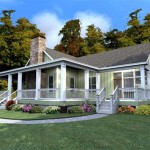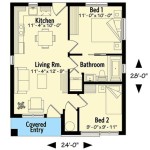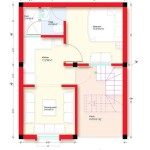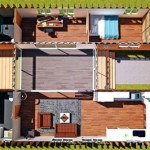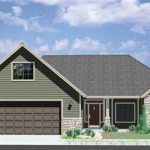One Story Bungalow Home Plans: A Comprehensive Guide
One story bungalow home plans represent a timeless architectural style characterized by their low-pitched roofs, wide overhanging eaves, prominent front porches, and open floor plans. These homes, often associated with the Arts and Crafts movement, prioritize simplicity, functionality, and a connection with the surrounding landscape. Choosing a one story bungalow home plan involves careful consideration of various factors, including lifestyle, budget, lot size, and personal preferences. This article provides a detailed overview of one story bungalow home plans, exploring their key features, advantages, design considerations, and the process of selecting the right plan for your needs.
Key Characteristics of One Story Bungalow Home Plans
Bungalows, in their essence, are designed for comfortable and convenient living within a single level. Their distinctive features contribute to their aesthetic appeal and practical functionality. Understanding these key characteristics is crucial for anyone considering this architectural style.
Low-Pitched Roofs: A defining feature of bungalows is their low-pitched roof, often featuring gables or dormers for added visual interest and attic ventilation. These roofs typically extend beyond the exterior walls, creating wide overhanging eaves that provide shade and protect the siding from the elements. The low pitch also simplifies maintenance and reduces the visual impact of the roofline, contributing to the bungalow's understated elegance.
Wide Overhanging Eaves: The wide overhanging eaves are not merely decorative; they serve a practical purpose. They shield windows and walls from direct sunlight and rain, reducing energy consumption for cooling and preventing moisture damage. This feature also creates a covered area around the perimeter of the house, enhancing the outdoor living experience.
Prominent Front Porches: Bungalows are known for their inviting front porches, often spanning the entire width of the house. These porches provide a welcoming transition from the street to the interior and offer a comfortable space for relaxation and socializing. Porches are typically supported by substantial columns or posts, adding to the bungalow's solid and grounded appearance.
Open Floor Plans: Interior layouts in bungalow home plans often prioritize open floor plans, connecting the living room, dining room, and kitchen into a single, unified space. This design promotes social interaction and creates a sense of spaciousness, even in smaller homes. The open floor plan also allows for greater flexibility in furniture arrangement and interior design.
Natural Materials: Bungalows often incorporate natural materials such as wood, stone, and brick. Exposed wood beams, hardwood floors, and natural stone fireplaces are common features that contribute to the bungalow's warmth and character. The use of natural materials reinforces the connection with the surrounding environment and adds a timeless quality to the home.
Horizontal Emphasis: Bungalows are characterized by their strong horizontal lines, which contribute to their sense of stability and grounding. This horizontal emphasis is achieved through the low-pitched roof, wide eaves, and the overall low profile of the house. The horizontal lines also visually connect the house to the landscape, creating a harmonious relationship between the built environment and nature.
Advantages of Choosing a One Story Bungalow Home Plan
Beyond their aesthetic appeal, one story bungalow home plans offer several practical advantages that make them a desirable choice for a wide range of homeowners. These advantages relate to accessibility, convenience, energy efficiency, and construction costs.
Accessibility and Aging in Place: One of the most significant advantages of a one story home is its accessibility. The absence of stairs makes it ideal for individuals with mobility issues, families with young children, and those planning to age in place. The single-level layout eliminates the risk of falls and allows for easy navigation throughout the house, enhancing safety and independence.
Ease of Maintenance: Maintaining a one story home is generally easier and less expensive than maintaining a multi-story house. Exterior maintenance, such as cleaning gutters and painting siding, can be done safely from the ground. Interior maintenance is also simplified, as there are no stairs to navigate with cleaning equipment or heavy objects.
Energy Efficiency: One story bungalows can be more energy-efficient than multi-story homes due to their compact design and reduced surface area. Heat loss through the roof is minimized, and the single-level layout allows for more efficient heating and cooling. Proper insulation and ventilation can further enhance the energy performance of a bungalow.
Simplified Construction: Constructing a one story bungalow is typically less complex and less expensive than building a multi-story house. The single-level design eliminates the need for extensive structural support and reduces the amount of scaffolding required. This can result in lower construction costs and a shorter construction timeframe.
Connection to the Outdoors: Bungalow home plans often prioritize a strong connection to the outdoors, with features such as large windows, French doors, and spacious porches. This design allows for ample natural light and ventilation, creating a comfortable and inviting living environment. The connection to the outdoors also promotes a sense of well-being and contributes to the bungalow's overall appeal.
Design Considerations for One Story Bungalow Home Plans
Selecting the right one story bungalow home plan involves careful consideration of various design factors, including lot size, layout, orientation, and interior design. A well-designed bungalow should maximize space utilization, optimize natural light, and create a comfortable and functional living environment.
Lot Size and Orientation: The size and orientation of the building lot are crucial factors in determining the appropriate bungalow home plan. A larger lot allows for a more expansive bungalow with a wraparound porch and a spacious backyard. The orientation of the house should be carefully considered to maximize sunlight exposure and minimize heat gain during the summer months. Southern exposure is generally preferred for living areas, while bedrooms can be oriented towards the east for morning sunlight.
Layout and Functionality: The layout of a one story bungalow should prioritize functionality and ease of use. The open floor plan should allow for seamless transitions between the living room, dining room, and kitchen. Bedrooms should be located away from high-traffic areas to ensure privacy and quiet. Adequate storage space is essential, and closets should be strategically located throughout the house.
Window Placement and Natural Light: Windows play a crucial role in providing natural light and ventilation. Large windows should be strategically placed to maximize sunlight exposure and minimize glare. Transom windows above doorways can add additional light and visual interest. Window placement should also consider privacy and views of the surrounding landscape.
Interior Design and Finishes: The interior design of a bungalow should complement its architectural style. Natural materials, such as wood, stone, and brick, should be incorporated whenever possible. Warm and inviting colors should be used to create a comfortable and welcoming atmosphere. Furniture should be chosen for its functionality and aesthetic appeal. Built-in features, such as bookcases and cabinets, can maximize space utilization and add to the bungalow's character.
Accessibility Features: When designing a one story bungalow, it is important to consider accessibility features that can make the home more comfortable and convenient for individuals with mobility issues. These features may include wider doorways, grab bars in bathrooms, and ramps instead of steps. Incorporating accessibility features can significantly enhance the livability of the home for people of all ages and abilities.
Outdoor Living Spaces: Bungalows are known for their strong connection to the outdoors, and outdoor living spaces should be an integral part of the design. A spacious front porch provides a welcoming entry and a comfortable space for relaxation. A backyard patio or deck extends the living space outdoors and provides a venue for outdoor dining and entertaining. Landscaping should be carefully considered to create a harmonious transition between the house and the surrounding environment.
When considering specific plans, it's beneficial to carefully review the square footage of each room, the placement of windows, and the overall flow of the floor plan. Understanding the specifics of the plan will allow for better customization and ensure the final result meets your needs.

Unique One Story House Plans Monster

Stylish One Story House Plans Blog Eplans Com

Small One Story 2 Bedroom Retirement House Plans Houseplans Blog Com
House Plan Of The Week Simple One Story Design Builder

Single Story House Floor Plans Y New

Must Have One Story Open Floor Plans Blog Eplans Com

Pin On Homes

Our Favorite Unique One Story House Plans Blog Dreamhomesource Com

Stylish One Story House Plans Blog Eplans Com

Small One Story 2 Bedroom Retirement House Plans Houseplans Blog Com

